Parks Group Acts on Skatepark, Millage
Ann Arbor park advisory commission meeting (June 19, 2012): Park commissioners took action on three items that now will likely be on the Ann Arbor city council’s July 16 agenda: (1) a contract for the design of a proposed Ann Arbor skatepark, (2) path renovations at Leslie Science & Nature Center, and (3) a parks millage renewal.
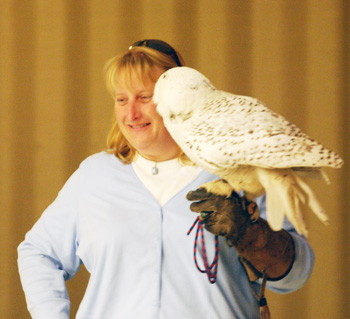
Francie Krawcke, raptor program director with the Leslie Science & Nature Center, brought a snowy owl to the June 19, 2012 meeting of the Ann Arbor park advisory commission. The owl did not fly around council chambers, but did enjoy a few snacks at the meeting. (Photos by the writer.)
An $89,560 contract with Wally Hollyday Skateparks – for design and construction oversight of a new skatepark at Veterans Memorial Park – was unanimously recommended for approval. Trevor Staples, president of the Friends of the Ann Arbor Skatepark, was on hand to answer questions, and several commissioners congratulated him for spearheading this project. Staples noted that fundraising is still underway, focused now on building a $100,000 endowment for future maintenance. Funding for design and construction of the skatepark has been secured primarily from a $300,000 state grant and $400,000 from the Washtenaw County parks & recreation commission.
PAC also unanimously recommended approval of a $115,309 contract with JB Contractors Inc. to build barrier-free pathways at the Leslie Science & Nature Center. The recommendation includes a 10% contingency, for a total project cost of $126,840.
This first phase of a broader renovation project on the center’s grounds will include making the raptor enclosures – housing owls, falcons, a bald eagle and other birds of prey – more accessible. The center, located at 1831 Traver Road, was previously part of the city’s parks system, but since 2007 has operated as an independent nonprofit. However, the city still owns and maintains the buildings and property.
Also unanimously recommended for approval was placement of a millage renewal on the Nov. 6 ballot. The current 1.1 mill Ann Arbor park maintenance and capital improvements millage expires this year. A renewal would run from 2013-2018 and is expected to generate about $4.9 million next year.
The June 19 meeting included a quarterly financial update, and the election of Tim Doyle as chair of PAC’s budget and finance committee. Commissioners also were briefed on a Traver Creek streambank stabilization project at Leslie Park golf course, designed to improve the water quality of this Huron River tributary.
Other water-related issues were brought up during the parks and recreation manager’s report. Colin Smith told commissioners that final repairs on swirl concentrators at West Park – designed to help stormwater management – will start later this month, with final renovations of the park occurring over the summer. And city staff will be harvesting Eurasian watermilfoil from about 6-7 acres around the Gallup Park canoe livery, using what Smith described as a “Zamboni on the water.” The aquatic plants have overgrown the area around the livery, making it hard for people to use paddleboats, canoes and kayaks.
During public commentary, Alan Haber urged commissioners to support the Library Green project, a citizen-led effort to put a public commons on top of the new city-owned Library Lane underground parking structure. He invited PAC to a July 14 “Imagine a Park” block party on the site, from noon until 5 p.m. Later in the meeting, park commissioner Tim Berla picked up the idea, saying he wasn’t advocating for that particular project but that he felt PAC should be “in the game” for discussions of a downtown park.
The June 19 meeting was the last one for commissioner David Barrett, who is term-limited after serving two three-year terms. PAC chair Julie Grand praised his work, particularly in advocating for renovations to the city’s athletic fields and ballparks. The mayor has not yet publicly put forward a nomination for Barrett’s replacement.
Ann Arbor Skatepark
Commissioners were asked to recommend approval of a contract with Wally Hollyday Skateparks for the Ann Arbor Skatepark at Veterans Memorial Park. The $89,560 contract would cover design and construction oversight of the project.
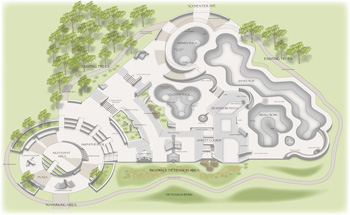
Sketch from the Wally Hollyday Skateparks proposal for the Ann Arbor skatepark at Veterans Memorial Park. Hollyday told The Chronicle that he considers this an example that addresses many of the community’s desires for the skatepark, but that considerable public input will be sought to shape his development of the design.
A selection committee reviewed six responses to a request for proposals (RFP) issued by the city of Ann Arbor in April, and selected two California firms – Wally Hollyday Skateparks and Wormhoudt Inc. – as finalists. Additional review and interviews resulted in the choice of Wally Hollyday Skateparks as the recommended designer. Wally Hollyday had already been involved in the project to some extent, leading design workshops for the Friends of the Ann Arbor Skatepark in 2009 and 2010.
The roughly $1 million project – including an anticipated $100,000 endowment for ongoing maintenance – will be financed through a combination of funds. Those include private donations – primarily solicited through the Friends of the Ann Arbor Skatepark – as well as a $300,000 state grant, and up to $400,000 in matching funds from the Washtenaw County parks and recreation commission. The Ann Arbor Area Community Foundation is acting as fiduciary.
Representatives from all of these groups attended PAC’s June 19 meeting: Trevor Staples, president of Friends of the Ann Arbor Skatepark; Jeff Dehring of the Washtenaw County parks & recreation department; and Jennie Hale, development/program officer with the community foundation.
Park planner Amy Kuras is the city’s point person on the project, and briefed commissioners on the selection process. The pre-qualifications were written tightly, she said, including requirements like a minimum of 10 years experience in designing and overseeing skatepark construction, extensive work with municipalities, building in climates similar to Michigan, a track record of at least 10 parks that have been in place at least 10 years, and experience with stormwater management.
The two finalists rose to the top pretty quickly among the six bids that were submitted, Kuras said.
Staples also addressed commissioners, reminding them that it’s been about five years since skatepark supporters filled council chambers to advocate for the project. He thanked PAC for its support. [At its March 2011 meeting, PAC had recommended support for the city to apply for the $300,000 Michigan Dept. of Natural Resources Trust Fund grant, with one commissioner – Sam Offen – voting against it. Offen ended his two terms on PAC in May.]
It had been exciting to go through the RFP process, Staples said, and they could have picked either of the finalists. But Hollyday is the right person for this job at this point, he added. Staples said he’s skated several skateparks designed by Hollyday, describing him as a skateboarder who is hands-on. “It’s art for him,” Staples said.
Ann Arbor Skatepark: Commission Discussion – Design
Several commissioners congratulated Staples for his work in spearheading this effort. Karen Levin said it sounded like Hollyday’s skateparks have stood up well over time, and she assumed that his design would take Michigan’s weather into account.
Staples noted that Hollyday is based in the San Diego area, as several skatepark companies are. It’s a specialized project that requires a particular kind of expertise. But the plan is to incorporate a lot of Michigan-based elements – labor and public art, for example. Regarding climate, Staples noted that part of the selection criteria included a requirement that the company have experience in building skateparks in northern climates.
David Barrett asked for more details about where the skatepark will be located. The site will be at the park’s northwest corner, near the intersection of North Maple and Dexter-Ann Arbor roads. Smith noted that there might be an opportunity for an amphitheater there, too.
Barrett, who served on the selection committee, said that even though the skatepark is for kids, it’s also for the entire community. The idea is to create a skatepark so that people can come and watch, even if they don’t “hop on a board” themselves, he said.
Smith added that the location is important because this will likely be a regional draw, and the site is close to I-94 and M-14 interchanges. It’s also close to businesses and neighborhoods, and is very visible and accessible, he said. As people enter the city from that area, it will be a very dynamic site.
Staples also clarified that the large stand of trees at that corner will remain in place. The trees are an asset, he noted – most skateparks don’t have shade.
During the discussion specifically about the resolution of support for the contract, Alan Jackson initially requested that the resolution strike the word “concrete” from this whereas clause:
Whereas, Construction of a custom, concrete skatepark is being proposed using funds from a State of Michigan Natural Resources Trust Fund Grant, Washtenaw County Parks and Recreation Commission and the Friends of Ann Arbor Skatepark to be constructed in Veterans Memorial Park;
Smith said it wouldn’t be possible to strike the word – the specifications are very specific. Staples explained that the main reason the resolution and RFP specified “concrete” is that many non-concrete skateparks are built in a modular way. That type of construction falls apart quickly and requires a lot of maintenance. The quality of a concrete skatepark is better.
Jackson withdrew his suggestion, saying that his intent simply had been to eliminate constraints on the project. Staples replied that the constraints are self-imposed.
Smith also pointed out that one aspect of the design includes stormwater management, in recognition of the fact that the skatepark will be adding impervious surfaces. The stormwater management might be in the form of rain gardens or other elements.
Tim Doyle noted that there are a number of design specs – are there any elements that PAC should be aware of, from a parks perspective? Kuras replied that the city will be relying heavily on Hollyday for this project. Midwestern Consulting, a civil engineering firm based in Ann Arbor, will be hired as a subcontractor to handle certain aspects, she said. But it will be a collaborative process, she added, to work through any concerns that might arise.
Ann Arbor Skatepark: Commission Discussion – Financing
John Lawter asked whether all of the fundraising was in place. Fundraising is still happening, Staples replied. The goal is $1 million – $900,000 for design and construction, and $100,000 for an endowment to fund future maintenance. The majority of the $820,000 they’ve raised so far is in the form of grants, which can’t be used for the endowment, he said. So the focus now is on the endowment. He noted that he had dropped off a pile of bricks at Arnet’s Monuments earlier that day to be engraved as part of a fundraising drive.
Lawter asked how someone could buy a brick. Staples explained that details are on the Friends of the Ann Arbor Skatepark website, where payments can be made online. There are three sizes: $100, $250 and $1,000. Purchases are tax deductible, he said.
The group will also have a booth at the Ann Arbor art fairs, he said, in the nonprofit section.
Christopher Taylor observed that about $100,000 is “in the bank,” but he wondered when the remaining funds would “land.” Smith reported the city expects that the $300,000 DNR grant will be distributed later this summer. After that, the county’s $400,000 in matching funds will be available. Jeff Dehring of the Washtenaw County parks & recreation department clarified that county funds would be available as soon as the construction contract is awarded. Staples noted that the design needs to be completed before state funds can be accessed, and Amy Kuras added that the state funds are actually reimbursements – so the city would pay, and be reimbursed from the DNR grant.
In response to a question from Tim Berla, Smith explained that the Ann Arbor Area Community Foundation is holding the funds now, but later the money will be transferred into a segregated city account for the project. There also is a reference in a memorandum of intent regarding how the funds will be transferred, he said. [The city council approved the MOI with the Ann Arbor Skatepark Action Committee – the predecessor to the nonprofit Friends of the Ann Arbor Skatepark – at its Dec. 1, 2008 meeting. .pdf of 2008 memorandum of intent]
Do the other funders have to give approval for the selection of the Hollyday? Berla asked. Smith replied that the other groups had input via their membership on the selection committee. Staples added that all parties have agreed on this decision.
Tim Doyle observed that it’s a challenging project, and until it’s designed and the construction bids are in, it’s difficult to know how much it will actually cost.
Ann Arbor Skatepark: Next Steps
Colin Smith explained that the plan is to put this contract on the city council’s July 16 agenda. If approved, the project will move forward for design and construction. Amy Kuras noted that several public meetings will be held to get input on the design, and when a design is developed, it will be presented to both PAC and the city council for review and input. The hope is to have a design and construction drawings finalized by early fall to put the project out to bid for a builder, with the goal of starting construction in the spring of 2013.
Over the winter, Smith said, he’d work with Staples to develop an operating agreement for the facility.
Outcome: Commissioners unanimously recommended that the city council approve a contract with Wally Hollyday Skateparks. It will now be forwarded to the city council for review, likely at the council’s July 16 meeting.
Leslie Science Path Renovations
In an item added to the agenda during the June 19 meeting, PAC was asked to recommend approval of a $115,309 contract with JB Contractors Inc. to construct barrier-free pathways at the Leslie Science and Nature Center. The recommendation includes a 10% contingency, for a total project cost of $126,840.
JB Contractors provided the lowest of two bids. Fonson Inc. had submitted a much higher bid of $197,459. Funding is available from the city’s park maintenance and capital improvements millage.
PAC had been briefed on this project – the first phase of a larger renovation – at its Feb. 28, 2012 meeting. The center, located at 1831 Traver Road, was previously part of the city’s parks system, but since 2007 has operated as an independent nonprofit. However, the city still owns and maintains the buildings and property.
Parks planner Amy Kuras told commissioners that the goal of the changes to the pathways is to make the center compliant with requirements of the Americans with Disabilities Act (ADA), and to make the pathways and overall organization of the site less confusing. The project includes replacing the paths that connect various buildings on the site, and constructing new paths to connect the center’s raptor enclosures.
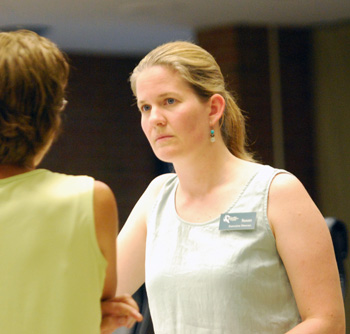
From right: Susan Westhoff, executive director of the Leslie Science & Nature Center, talks with city park planner Amy Kuras.
Those enclosures house owls, falcons, a bald eagle and other birds of prey, and are located at the highest part of the site. The birds are very popular, so the intent is to make the area as accessible as possible. The paths connecting the raptor enclosures will be made from porous pavement of recycled glass, Kuras said. In addition to pathways, there will be better signs indicating how to get to the enclosures, as well as directions to other parts of the center.
A master plan for the broader project includes renovating the parking lot, creating a new drop-off are, and reconfiguring the remaining paths.
Kuras said construction drawings for this phase are complete, and she hoped that following PAC’s recommendation, a resolution could be placed on the city council’s July 16 agenda. If approved, construction could start after Labor Day and would likely last a couple of months.
Susan Westhoff, the center’s executive director, attended the June 19 PAC meeting and spoke briefly about the need for the path improvements and overall renovations. Francie Krawcke, the center’s raptor program director, was also on hand with a snowy owl, which she kept on a tether and fed snacks during the presentation.
Leslie Science Path Renovations: Commission Discussion
Karen Levin asked how long the project would taken and if it would impact the center’s programming. Amy Kuras estimated that construction could last 6-8 weeks, though there was not yet a schedule. Much like the current work in Buhr Park and Cobblestone Farm, she said, it will be coordinated closely with staff. [The Buhr/Cobblestone contract – $865,190 to Fonson Inc. for road, parking, pathway and other exterior renovations – was recommended for approval at PAC's Feb. 28, 2012 meeting, and subsequently authorized by the city council.]
Kuras said she’s stressed to the contractor the importance of safety, since the work will be done while people are coming to the center. When people call the center to reserve space for events, they’ll be informed about the work, too. There will be constant information-sharing, Kuras said.
David Barrett asked if Kuras had ever worked with this contractor. No, she said, but the firm recently merged with Abbott Concrete, a company she has worked with. She told commissioners that she’d keep reminding the workers that the job is in a public park.
Responding to a question from Alan Jackson, Kuras clarified that the circular drive would remain in place as a drop-off, until the second phase of the project. That phase, which hasn’t yet been bid out, would require additional recommendation by PAC and authorization by city council.
Julie Grand asked whether schools had also been notified about the work. Susan Westhoff replied that September, when the work will start, is typically a light programming month for the center. And a lot of the October programming tends to be staff going out to schools, rather than students coming to the center, she said. The only building that won’t be accessible during the work is the Critter House, which is completely surrounded by the sidewalk that’s being rebuilt.
Outcome: Commissioners unanimously recommended approval of a $115,309 contract with JB Contractors Inc. for barrier-free pathways at the Leslie Science and Nature Center. The recommendation will be forwarded to the city council.
Park Millage Renewal
On the PAC agenda was a resolution recommending that city council put a 1.1 mill renewal of the Ann Arbor park maintenance and capital improvements millage on the Nov. 6 ballot.
The current 1.1 mill tax expires this year. A renewal would run from 2013-2018 and raise about $4.9 million next year. The recommended allocation of revenues is 70% for park maintenance activities, and 30% for park capital improvement projects. Of that allocation, up to 10% can be shifted between the two categories as needed.
Examples of park maintenance activities include “forestry and horticulture, natural area preservation, park operations, recreation facilities, and targets of opportunity,” according to a staff memo. Capital improvement projects would cover parks, forestry and horticulture, historic preservation, neighborhood parks and urban plazas, park operations, pathways, trails, boardwalks, greenways and watersheds, and recreation facilities.
PAC was first briefed about the millage renewal at its March 22, 2012 meeting. At the time, PAC chair Julie Grand – who served on a working group to strategize about the renewal – said concerns about the economic climate were a major reason why an increase wasn’t being recommended. City parks staff and PAC members subsequently held several public forums about the renewal that were sparsely attended.
The proposed ballot language reads as follows: “Shall the city renew the existing park maintenance and capital improvements millage for 2013 through 2018, which will raise in the first year of the levy an estimated revenue of $4,900,000 for park maintenance and park capital improvements?”
Colin Smith, the city’s parks and recreation manager, gave a brief overview of the process to date, noting that the city council would need to take action in order to put the millage renewal on the November ballot. At that point, the city staff could have additional public forums to educate the community about the renewal request and how the millage revenues are used.
A public hearing on the millage had been held at PAC’s April 2012 meeting, but no one attended. On June 19, there were no comments or questions from commissioners about the renewal.
Outcome: Commissioners voted to recommend that city council put the millage renewal on the Nov. 6, 2012 ballot.
Traver Creek Stabilization
Harry Sheehan, environmental manager for the Washtenaw County office of the water resources commissioner, was on hand to update PAC about a Traver Creek streambank stabilization project at Leslie Park golf course. Commissioners had initially been briefed about the project at their Dec. 20, 2011 meeting by Jen Lawson, the city’s water quality manager.
Sheehan told commissioners that the purpose of the project is to improve water quality flowing into the Huron River – Traver Creek is a tributary. The project aims to reduce the amount of phosphorus that’s discharged into the river, address erosion and flooding issues, control the amount of sediment that’s being deposited downstream, enhance the wetlands and habitat for wildlife, and improve the aesthetics of the Leslie Park golf course.
The city council had authorized petitioning the county for the $1.05 million project at its Jan. 9, 2012 meeting. The city’s portion is $981,540, which will be assessed by the county over a period of up to 20 years, at a maximum of $62,415 per year, according to a staff memo prepared for council. The first payment was included in the FY 2013 stormwater fund operations and maintenance budget, approved by the council earlier this year.
The resolution passed by the council on Jan. 9 also authorized annual payments to the county for this project from the stormwater fund (Fund 0069). The project has been approved for a 2.5% low-interest loan from the state revolving fund, and up to 50% of the loan could be forgiven by the state.
Sheehan reported that the construction work is out for bid, and the plan is to start work in November of 2012, after the golf season ends, through March of 2013.
It’s essentially a drain project, Sheehan said, but the work is being done with an understanding of the site’s special nature within a golf course.
Traver Creek Stabilization: Commission Discussion
John Lawter asked for more details about how the position of the creek would be affected. Sheehan explained that the creek would be made more “meandering,” compared to its current course.
David Barrett wondered what will happen if all the work can’t be done within the November-to-March timeframe – would it be delayed until the following winter? And if so, how would that affect the project’s financing?
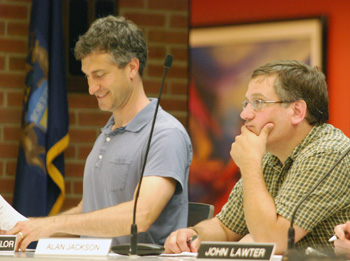
From left: Christopher Taylor, a Ward 3 city councilmember and ex-officio member of PAC, and Alan Jackson, one of the newest PAC members.
There’s no hard deadline for getting the work done, Sheehan replied. If next winter was like the most recent one, then it won’t be a problem to do the work, he said. The final part of the project is more contained to the area around the south part of the course, so conceivably that work could be done during the summer, and it wouldn’t disrupt play.
Alan Jackson wanted to know how the project is being coordinated with the city’s golf staff. Sheehan said the golf staff have been integrated into the design process. They’ve provided suggestions for removal of sediment and its use elsewhere on the course – for example, to fill in areas that are chronically wet.
Jackson also asked whether any public meetings had been held. Yes, Sheehan said. The first one was held several years ago to discuss the financing aspect, he said. Earlier this year, about 25 people – mostly stakeholders in the golf community – attended a public forum on the project. Another forum held a few weeks ago drew only one person, he said, although residents in the nearby neighborhoods were all sent notices.
Colin Smith, the city’s parks and recreation manager, said the golf staff have been involved from the outset. There has also been communication with golfers about the project, as well as with other user groups. All the feedback has been positive, he said.
Responding to a question from Tim Doyle, Smith reported that because of warmer-than-usual weather, the golf courses opened this year in mid-March – usually, opening day is April 1. He noted that even if the courses were to open early in 2013, the work by that time would be more out of the way and wouldn’t disrupt play.
Jackson wanted to know whether ongoing maintenance costs would be incurred because of this project. Sheehan replied that sediment maintenance would likely be needed every two to five years, but would cost only in the $2,000 to $5,000 range. The costs would be handled through an assessment fee paid by the city, but the work would be done through the county’s office of the water resources commissioner.
Outcome: This was not an action item – no vote was required.
Financial Update
Colin Smith, the city’s parks and recreation manager, walked commissioners through a quarterly update of the parks and recreation budget. The current fiscal year ends June 30, 2012. [.pdf of parks & rec quarterly financial statement]
Recreational facilities supported by the city’s general fund are forecast to bring in $2,372,166 in revenues for the fiscal year, about $6,000 more than budgeted. Expenses of $3,442,592 are $17,500 less than budgeted. That means $1,070,426 will be used from the general fund to cover the difference between revenues and expenses.
Three units – the farmers market, Huron Hills golf course, and Leslie Park golf course – are operated in “enterprise funds,” where the expectation is that revenues will cover expenses.
For the farmers market, revenues are projected to be on budget at $165,118. Projected expenses of $160,118 are $5,000 lower than budgeted, in part because of a transitional period between the departure of former market manager Molly Notarianni and the hiring of Sarah Benoit, who was introduced at PAC’s May meeting.
At Huron Hills, revenues of $382,375 are on budget, while expenses of $541,080 are $7,500 lower than budgeted. The general fund will contribute $158,705 to operations at Huron Hills.
The Leslie Park golf course is expected to bring in revenues of $901,319 – about $20,000 less than budgeted. Expenses of $999,580 are also about $20,000 lower than budgeted. The general fund will contribute $98,261 to fund that golf course.
Matt Warba, supervisor of field operations, reviewed the financial statements for those parks operations that funded out of the park maintenance and capital improvements millage. He noted that expenses will be about $300,000 lower than the budgeted $2.353 million because the unit did not have a full complement of full-time staff this year. However, over the past month four full-time employees have been hired – two paid for from the general fund, and two from the millage.
There are 12 employees in field operations now, plus about 18 seasonal workers. The additional staff allows for a mowing cycle of 14 days, compared to the previous 19-day cycle.
Financial Update: Election of Committee Chair
Later in the meeting, the commission took action related to park finances – by voting on a new chair for the group’s budget and finance committee. It had previously been chaired by Sam Offen, whose term on PAC ended last month.
PAC chair Julie Grand nominated Tim Doyle, who’s been working with Offen on the committee. Doyle had been expected to take that leadership role.
In announcing her nomination, Grand told Doyle, “You’d better not say no!” He did not.
Outcome: Tim Doyle was unanimously elected chair of PAC’s budget and finance committee.
Library Green: PAC Action?
During public commentary, the only speaker was Alan Haber, who told commissioners that he frequently had spoken to other public bodies like the Ann Arbor city council on behalf of a group that’s trying to develop a community park, commons and gathering place on top of the Library Lane underground parking structure. Recently, members of the advocacy group had suggested coming to PAC as well. He asked commissioners to urge the Ann Arbor Downtown Development Authority to separate out the Library Lane from its consideration of other parcels in the downtown area.
[Haber was referring to an effort called Connecting William Street, which is exploring alternate uses for the surface parking lots in the area bounded by William, Ashley, Liberty and Division streets – including the top of the underground parking structure. The project is being undertaken by the DDA at the direction of the Ann Arbor city council, given last year on April 4, 2011.]
The DDA should separate out the Library Lane parcel, Haber said, and gather ideas from the community about how to make a Central Park-type gathering space. There are so many people who say that’s what they want, he said – ask anyone whether they want a building or a park, and almost everyone will say a park. But this effort needs energy from people with responsibility for the parks who can actively pursue it. Don’t wait until another plan is presented, he said. He urged PAC to take some initiative. Haber said that advocates for Library Green are having an “Imagine a Park” block party on July 14, a couple of days after the grand opening of the parking structure earlier in the day. The event will run from noon until 5 p.m. on the top of the structure.
Haber contended that the conversation about this option was completely suppressed by the group that evaluated a request for proposals (RFP) for the top of the Library Lane. PAC should start to think about the possibility, and offer its advice to the DDA, he said.
Library Green: PAC Action? – Commission Discussion
Later in the meeting, Tim Berla asked what the process would be for following up on Haber’s suggestion. He felt that PAC should get ahead of the issue regarding downtown parks. It seems like there does need to be a park downtown. The Library Lane site might be an obvious place, though not necessarily the best place – and Berla said he wasn’t advocating for that. But he wanted PAC to get in the discussion. Berla said he knows that money is part of it, in terms of whether a park will raise the value of land surrounding it. But he didn’t think PAC should be involved in evaluating the financial aspects. His question was this: What can PAC do to move the discussion along so that the commission’s input is given? Berla said he’d been surprised that a surface parking lot is going on top of the 700-space underground structure, which seemed odd, though it might be the cheapest option at this point.
Colin Smith, the city’s parks and recreation manager, said that PAC always has the option of forming a subcommittee or focus group to look into any issue. If that’s what the commission as a whole wants to do, it can do that. There are a lot of discussions related to city-owned property in and near downtown, he noted, including the Allen Creek greenway, 415 W. Washington and 721 N. Main sites, and Liberty Plaza – a city park at the southwest corner of Liberty and Division, near the underground parking structure. From the staff’s perspective, Smith said, it would make sense for PAC as a group to decide what it wants to do.
PAC chair Julie Grand noted that at the last meeting of PAC’s land acquisition committee, committee members talked about holding a priority-setting session after all of the new commissioners come on board. [Gwen Nystuen and Sam Offen recently left PAC, and the June 19 meeting was the last one for David Barrett. All were term-limited. Ingrid Ault and Alan Jackson were appointed to replace Nystuen and Offen, but Barrett's replacement hasn't been appointed yet.]
Berla said he’d like to see several different plans developed for the Library Lane site, so that people could start evaluating options. Another insight he’d had related to Sonic Lunch – the weekly summer music series that’s held in Liberty Plaza and organized by the Bank of Ann Arbor. Wouldn’t it be awesome to have a music performance space downtown? He wanted to explore ideas like this, though perhaps they should wait until the Connecting William Street process played out, though it seemed like the focus for that project was different.
John Lawter noted that members of PAC and the DDA had met, and he had thought there would be a follow-up meeting. Julie Grand agreed, and said that one approach would be to advocate for involvement in the Connecting William Street effort.
Smith said that in the past, the city council has given PAC a charge to make recommendations back to the council. He asked Mike Anglin, a Ward 5 city councilmember who is an ex officio member of PAC, if Anglin knew who might be working on this issue. [PAC's other council representative, Christopher Taylor (Ward 3), had left the June 19 meeting by that point.]
Anglin replied that a lot of things are happening, and it’s important for PAC to be involved. Fuller Road is another area of interest, he said – an allusion to the possibility of building a transit station on land that’s part of Fuller Park. He noted that the Ann Arbor District Library is discussing what to do on its downtown site, too. It would be good for PAC to be more actively involved, he said, and perhaps form a focus group that could track some of these projects.
Outcome: There was no action taken on this issue, and it’s not clear if there’s consensus among commissioners about what steps to take next.
Parks & Recreation Manager’s Report
Colin Smith gave updates on two projects during his manager’s report: Repairs of the swirl concentrators at West Park, and “aquatic plant management” near the Gallup Park canoe livery.
Parks & Rec Manager’s Report: West Park
In late June, Smith said, the city expects the manufacturer of the swirl concentrators at West Park to replace the lids and finish repairs on those units. That work should take about three weeks. After that, the project’s contractor will rebuild the diversion structures, finish the access paths, and complete native plant restoration in that area, located along Seventh Street. That work will likely last throughout the summer. There are three entrances to the park off of Seventh, and during this work only the middle entrance will remain open, he said. Other activities at the park will be uninterrupted. He told commissioners that updates will be posted online.
Swirl concentrators had been installed for stormwater management as part of a major renovation of West Park in 2010. Most recently, PAC received a detailed update on the project at its Jan. 24, 2012 meeting from Nick Hutchinson, a civil engineer and one of the project managers in the city’s public services unit. Hutchinson had told the commission that after the manufacturer of the swirl concentrators makes repairs on the units, the city would hire a contractor to complete additional work that was recommended by Orchard Hiltz & McCliment (OHM), which the city had engaged in 2010 to look into the problems with that aspect of the West Park project. City staff had previously hoped to have that work completed by July of 2012.
Parks & Rec Manager’s Report: Aquatic Plants at Gallup
Smith reported that aquatic plants near the Gallup Park canoe livery are extremely overgrown, and that city staff will be harvesting excess plants in the coming weeks. Specifically, Eurasian watermilfoil is making it difficult for people to use paddleboats or canoe on that part of the pond.
Staff will use what Smith described as a “Zamboni on the water” to harvest about 6-7 acres around the livery. They’ll deposit the plants in an area of the park that’s unused, where the plants will dry out and shrink, he said. The work will start in late June.
Farewell to David Barrett
Turnover of park commissioners continued at the June 19 meeting – the last one for David Barrett, who has served on PAC since 2006.
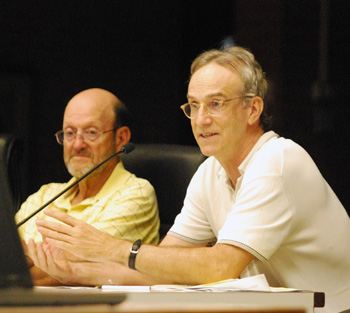
From left: Park advisory commissioners Tim Doyle and David Barrett. The June 19 meeting was the last one for Barrett, whose term expires this month.
Near the end of the meeting, PAC chair Julie Grand thanked Barrett for his service. He had been a tireless advocate for improving the city’s athletic fields, she noted, and had been a quiet advocate on a lot of other issues over the past six years. He was an incredible human being and a good soul, she said.
Barrett is a songwriter and musician who is best known for the song “One Shining Moment.” It’s become the anthem for the NCAA basketball finals, with versions sung by Luther Vandross and Jennifer Hudson. He has written music for other sporting events and TV networks, and won an Emmy for the score of a PBS documentary on C.S. Lewis.
Barrett thanked the mayor for his appointment, and also thanked his fellow commissioners. He praised the city’s parks staff, saying they do a great job. It’s been an honor to serve, he said.
Barrett is the latest of three PAC members who have left the commission after being term-limited. Park advisory commissioners are limited to two consecutive three-year terms. Sam Offen and Gwen Nystuen recently ended their two terms on PAC as well. New commissioners replacing Offen and Nystuen are Alan Jackson and Ingrid Ault. No replacement has been nominated yet for Barrett.
Two other commissioners – Doug Chapman and Karen Levin – will be ending their first three-year terms in September of 2012, and could seek reappointment for another term.
Present: Ingrid Ault, David Barrett, Tim Berla, Tim Doyle, Alan Jackson, John Lawter, Karen Levin, Julie Grand, councilmember Christopher Taylor (ex-officio), councilmember Mike Anglin (ex-officio). Also Colin Smith, city parks and recreation manager.
Absent: Doug Chapman.
Next meeting: PAC’s meeting on Tuesday, July 17, 2012 begins at 4 p.m. in the city hall second-floor council chambers, 301 E. Huron St., Ann Arbor. [Check Chronicle event listing to confirm date]
The Chronicle survives in part through regular voluntary subscriptions to support our coverage of public bodies like the Ann Arbor park advisory commission. If you’re already helping The Chronicle kickflip to financial sustainability, please encourage your friends, neighbors and coworkers to grab some air as well. Click this link for details: Subscribe to The Chronicle.




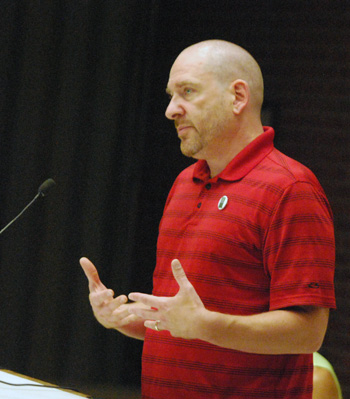
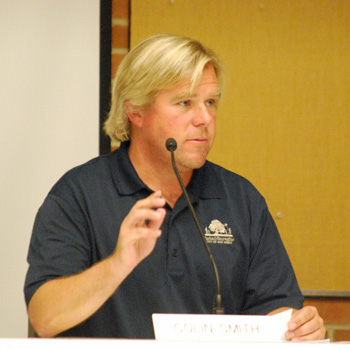
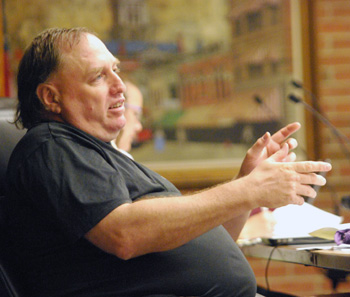
I wonder what is the date of Tim Berla’s term limit?
Re. “I wonder what is the date of Tim Berla’s term limit?”
According to the city’s listing of PAC members [link], Tim Berla’s term ends on Sept. 16, 2013. It lists his start date as March 4, 2002. I’m not sure why his tenure doesn’t conform to the limit of two consecutive three-year terms. It might be related to the fact that he’s the PAC representative from the city’s recreation advisory commission [link]. I’ll ask.
Re. Tim Berla’s term on PAC: Colin Smith, Ann Arbor’s parks and recreation manager, clarified that Berla is the recreation advisory commission’s representative to PAC – that is, he’s not appointed directly to PAC by city council. The RAC bylaws state that members of RAC elect a representative to PAC every two years, at RAC’s June meeting. There’s no indication in the bylaws that there are term limits of any kind. [.pdf of RAC bylaws]